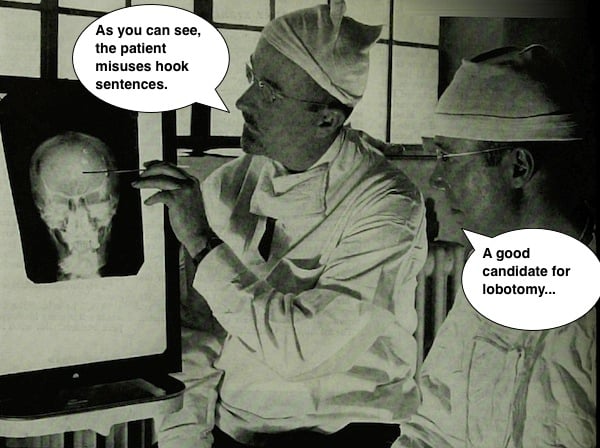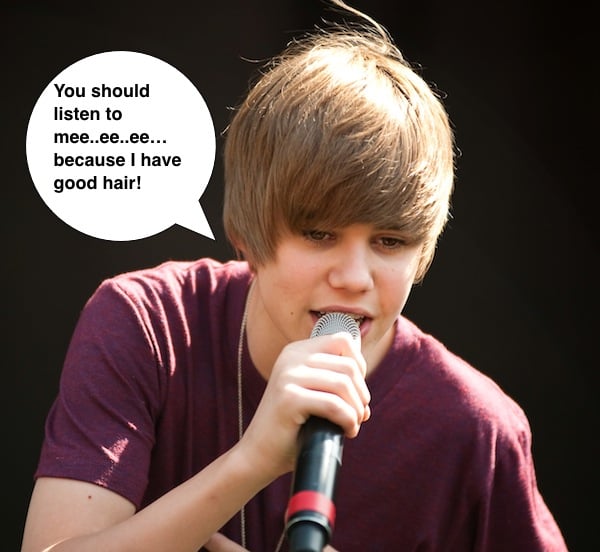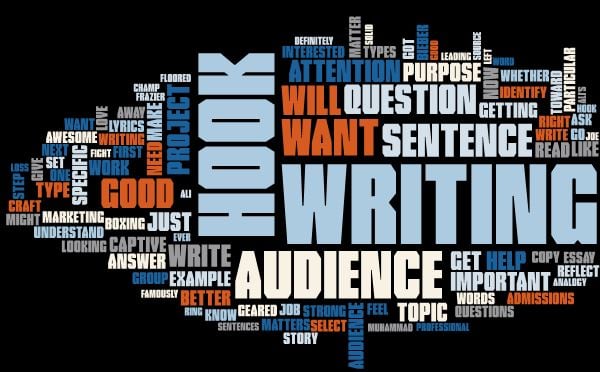In a 1971 fight, Joe Frazier famously floored boxing champ Muhammad Ali with a strong left hook, leading to Ali’s first ever professional loss in the boxing ring. This is most definitely not the source of the word “hook” in writing, but the analogy is as solid as Frazier’s punch. No matter what type of writing project you’re getting into right now, you need a strong hook that knocks your readers’ socks off and gets their attention.
When I talk about good hook sentences, I’m talking about that juicy string of words that make up the first sentence (or two) of your writing project—the words that grab your readers’ attention and don’t let go.
Good hook sentences say, “Drop everything you’re doing and read me right now,” without actually coming out and just saying that.
Writing good hook sentences is critical in all types of writing disciplines from essays and marketing copy to novels and short stories. Hooks are even used in song lyrics. I’m sure, on more than one occasion, you’ve fallen victim to an earworm (a set of lyrics that you can’t get out of your head). That’s because you got hooked. I got the eye of the tiger… oh…um, sorry, I wasn’t listening to Katy Perry, I swear!
Now, here’s the catch. There’s no single, tried and true formula to writing good hook sentences. There is no specific order of nouns, verbs, and adjectives that will get the job done. But when it comes time to KO your readers, this post will give you four simple steps to help you craft your perfect hook.
Good Hook Sentences Step 1—Identify Your Audience
Your hook sentence, just like the rest of your writing project, needs to speak to your specific audience. Getting the attention of a college professor is going to be a vastly different task than getting the attention of a group of stay-at-home moms, for example. Before you write your hook, ask yourself three key questions:
Question 1: Who is my audience?
It’s important to identify your audience no matter what type of writing project you’re working on. Doing so will help you select a message that speaks to them.
If you’re trying to get the attention of a bunch of middle school girls, for example, you either need to be Justin Bieber in the flesh or write a hook that is geared toward that age group.
If, however, your writing project is geared toward the admissions counselors at a prestigious university, you had better get a haircut, Bieber, and write your sentence appropriately.
Before setting out on this writing adventure, make note of your intended audience.
Question 2: Do I have a captive audience?
This question is important because it will help you better understand the purpose of your hook.
In the case of your teacher or an admissions counselor, you pretty much have a captive audience. They are being paid to read your writing. So the intention of your hook is to keep these people from falling asleep on the job, to entice them to give you a good grade, or to convince them to admit you into their institution.
If you’re writing a blog, a book, or marketing copy, then your audience is not captive, meaning they have a choice to read your work or not. Whether your writing appears online, at the bookstore, or on a publishing agent’s desk, your work is one second away from being skipped over in favor of the next piece of writing. In this scenario, a good hook is the lifeline of your writing.
Question 3: What matters to my audience?
Finally, you need to figure out what is important to your audience. Are they interested in solving a particular problem? Are they looking for a specific type of information? Do they want to know something interesting about you? Do they want to know that you understand a particular topic? Are they looking to be entertained?
Write down what matters to your audience. This will help you craft your ultimate hook sentence.
Good Hook Sentences Step 2—Identify the Purpose of Your Writing
The next important issue to determine is the purpose behind your writing. A good hook sentence must be consistent with your writing. You can’t just write an awesome sentence because it’s awesome, and then go off onto another topic entirely. That would just make you look like a crazy person.
 For example, if you are writing an argumentative essay, your hook should reflect the strength of your argument, perhaps by stating a shocking fact. On the other hand, if you’re writing a love story, you might start off writing a sweet and romantic anecdote. And if you’re writing a frightening essay on the topic of nuclear warheads, you might select to begin with a chilling statistic.
For example, if you are writing an argumentative essay, your hook should reflect the strength of your argument, perhaps by stating a shocking fact. On the other hand, if you’re writing a love story, you might start off writing a sweet and romantic anecdote. And if you’re writing a frightening essay on the topic of nuclear warheads, you might select to begin with a chilling statistic.
When identifying your purpose, ask yourself these two questions:
Question 1: How do I want my audience to feel?
Your answer could be that you want them to feel frightened, or motivated to action, or warm and fuzzy like they have a cute puppy on their lap, or interested in your life story.
The point is to write a hook that elicits the types of feelings you want your audience to have.
Question 2: What do I want my audience to take away?
Your answer could be that you want them to be better educated on a certain topic, or that you want them to question reality, or that you want them to believe in love again.
A good hook will reflect the purpose of your writing and set the stage for how you want your audience to feel and what you want them to take away from your work.
Good Hook Sentences Step 3—Choose Your Hook Wisely
Just as there is more than one way to skin a cat (not that I would know–I like my cats with skin and fur on them), there is more than one way to write a compelling hook that will grab your readers’ attention.
Here are a few of those ways:
1. Tell a humorous anecdote.
2. Reveal a startling fact.
3. Give an inspirational quote.
These are only three of many types of hooks. I could go on and on and on, but instead I created a resource just for you that features 14 different types of hooks plus example sentences.
To get this awesome resource and start your ideas flowing, just enter your email in the box at the bottom right of this screen. Your exclusive hook sentences will be instantly sent to your inbox.
Good Hook Sentences Step 4—Craft Your Hook
Now that you’ve considered your audience, the purpose of your work, and settled on the type of hook you want to write, it’s time to make it shine. A good hook sentence will use only the right words and will be as polished and refined as possible.
Honestly, this is how you should approach writing all of your sentences, but if you only have one absolutely perfect sentence in your work, let it be your hook.
One more note: even though your hook sentence is your very first sentence, it’s a good idea to write it last. By writing it last, you can better capture the tone and purpose of your entire writing project.
Remember, a good hook sets up expectations about your writing, establishes your credibility as a writer, grabs your readers’ attention, and makes them eager to read your work. If you need inspiration, you might check out these Kibin editors can help with that!
Good luck!
*Cover image credit: Spray flies from the head of challenger Joe Frazier, left, as heavyweight champion Muhammad Ali connects with a right in the ninth round of their title fight in Manila. (AP Photo/Mitsunori Chigita, File)

